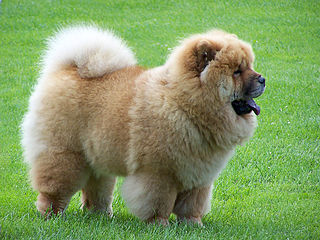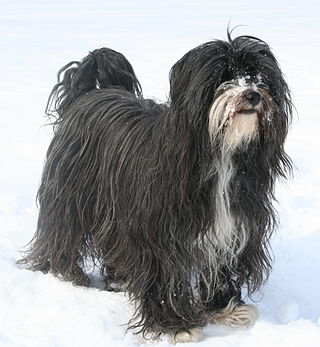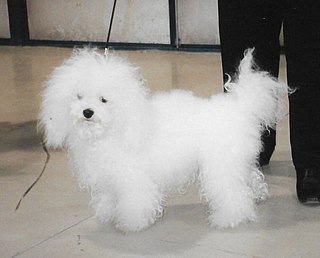
The Chow Chow is a spitz-type of dog breed originally from northern China. The Chow Chow is a sturdily built dog, square in profile, with a broad skull and small, triangular, erect ears with rounded tips. The breed is known for a very dense double coat that is either smooth or rough. The fur is particularly thick in the neck area, giving it a distinctive ruff or mane appearance. The coat may be shaded/self-red, black, blue, cinnamon/fawn, or cream.

The Shih Tzu is a toy dog breed originating from Tibet and was bred from the Pekingese and the Lhasa Apso.

The Pekingese is a breed of toy dog, originating in China. The breed was favored by royalty of the Chinese Imperial court as a companion dog, and its name refers to the city of Peking (Beijing) where the Forbidden City is located. The breed has several characteristics and health issues related to its unique appearance. Because of its desirable characteristics, the Pekingese has been part of the development of designer crossbreeds, such as the Peekapoo and Peke-a-tese.

Maltese dog refers both to an ancient variety of dwarf canine from Italy and generally associated also with the island of Malta, and to a modern breed of dog in the toy group. The contemporary variety is genetically related to the Bichon, Bolognese, and Havanese breeds. The precise link, if any, between the modern and ancient species is not known. Nicholas Cutillo suggested that Maltese dogs might descend from spitz-type canines, and that the ancient variety probably was similar to the latter Pomeranian breeds with their short snout, pricked ears, and bulbous heads. These two varieties, according to Stanley Coren, were perhaps the first dogs employed as human companions.

A spaniel is a type of gun dog. Spaniels were especially bred to flush game out of denser brush. By the late 17th century, spaniels had been specialized into water and land breeds. The extinct English Water Spaniel was used to retrieve water fowl shot down with arrows. Land spaniels were setting spaniels—those that crept forward and pointed their game, allowing hunters to ensnare them with nets, and springing spaniels—those that sprang pheasants and partridges for hunting with falcons, rabbits and smaller mammals such as rats and mice for hunting with greyhounds. During the 17th century, the role of the spaniel dramatically changed as Englishmen began hunting with flintlocks for wing shooting. Charles Goodall and Julia Gasow (1984) write that spaniels were "transformed from untrained, wild beaters, to smooth, polished gun dogs."
Toy dog traditionally refers to a very small dog or a grouping of small and very small breeds of dog. A toy dog may be of any of various dog types. Types of dogs referred to as toy dogs may include spaniels, pinschers and terriers that have been bred down in size. Not all toy dogs are lap dogs.

Chinese guardian lions, or imperial guardian lions, are a traditional Chinese architectural ornament, but the origins lie deep in much older Indian Buddhist traditions. Typically made of stone, they are also known as stone lions or shishi. They are known in colloquial English as lion dogs or foo dogs / fu dogs. The concept, which originated and became popular in Chinese Buddhism, features a pair of highly stylized lions—often one male with a ball which represents the material elements and one female with a cub—which represents the element of spirit, were thought to protect the building from harmful spiritual influences and harmful people that might be a threat. Used in imperial Chinese palaces and tombs, the lions subsequently spread to other parts of Asia including Japan, Korea, Philippines, Tibet, Thailand, Myanmar, Vietnam, Sri Lanka, Nepal, Cambodia, Laos, and Malaysia.

Spitz is a type of domestic dog characterized by long, thick, and often white fur, and pointed ears and muzzles. The tail often curls over the dog's back or droops. While all of the breeds resemble primitive dogs, smaller breeds resemble foxes, while larger breeds resemble jackals, coyotes, wolves, and even dingoes.

A bichon is a distinct type of toy dog; it is typically kept as a companion dog. Believed to be descended from the Barbet, it is believed the bichon-type dates to at least the 11th century; it was relatively common in 14th-century France, where they were kept as pets of the royalty and aristocracy. From France, these dogs spread throughout the courts of Europe, with dogs of very similar form being seen in a number of portraits of the upper classes of Germany, Portugal and Spain; from Europe, the type also spread to colonies in Africa and South America. The name "bichon" is believed to be a contraction of "barbichon", which means "little barbet".

A lap dog or lapdog is a dog that is both small enough to be held in the arms or lie comfortably on a person's lap and temperamentally predisposed to doing so. Lapdog is not a specific breed, but a generic term for a type of dog that is small in size and friendly towards humans.

A mastiff is a large and powerful type of dog. Mastiffs are among the largest dogs, and typically have a short coat, a long low-set tail and large feet; the skull is large and bulky, the muzzle broad and short (brachycephalic) and the ears drooping and pendant-shaped. European and Asian records dating back 3,000 years show dogs of the mastiff type. Mastiffs have historically been guard dogs, protecting homes and property, although throughout history they have been used as hunting dogs, war dogs and for blood sports, such as fighting each other and other animals, including bulls, bears and even lions.

The Lhasa Apso is a non-sporting dog breed originating in Tibet. It has traditionally been used as an interior sentinel.

The Tibetan Mastiff is a large size Tibetan dog breed. Its double coat is medium to long, subject to climate, and found in a wide variety of colors, including solid black, black and tan, various shades of red and bluish-gray, and sometimes with white markings around neck, chest and legs.

The Tibetan Spaniel is a breed of assertive, small dogs originating in Tibet. This breed is not a spaniel in the original meaning of the term; its breeding differs from other spaniels, and unlike true spaniels, which are gun dogs, the Tibetan spaniel is a companion dog. The spaniel name may have been given due to its resemblance to the bred-down lapdog versions of the hunting spaniels, such as the Cavalier King Charles spaniel.

The Tibetan Terrier is a medium-sized breed of dog that originated in Tibet. Despite its name, it is not a member of the terrier group. The breed was given its English name by European travelers due to its resemblance to known terrier breeds. The Tibetan name for the breed, Tsang Apso, roughly translates to "shaggy or bearded ("apso") dog, from the province of Tsang". Some old travelers' accounts refer to the dog as Dokhi Apso or "outdoor" Apso, indicating a shaggy or bearded working dog which lives outdoors.

The Eurasier, or Eurasian, is a spitz type breed of dog that originated in Germany through cross-breeding between popular European and Asian Spitz. It is widely known as a wonderful companion that maintains its own personality, has a dignified reserve with strangers, has a strong bond to its family, and is relatively easy to train.

The Bolognese is a small dog breed of the bichon type, originating in Italy. The name refers to the northern Italian city of Bologna. It is part of the toy dog group and is considered a companion dog.

The Cão de Gado Transmontano or Transmontano Mastiff is a breed of livestock guardian dog from Portugal. It originates in the historical province of Trás-os-Montes e Alto Douro in north-eastern Portugal, and is a rare breed confined mostly to this area.
















